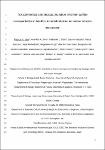Toxicokinetics and bioaccumulation of silver sulfide nanoparticles in benthic invertebrates in an indoor stream mesocosm
| dc.contributor.author | Silva, PV | |
| dc.contributor.author | Silva, ARR | |
| dc.contributor.author | Clark, NJ | |
| dc.contributor.author | Vassallo, J | |
| dc.contributor.author | Baccaro, M | |
| dc.contributor.author | Medvešček, N | |
| dc.contributor.author | Grgić, M | |
| dc.contributor.author | Ferreira, A | |
| dc.contributor.author | Busquets-Fité, M | |
| dc.contributor.author | Jurkschat, K | |
| dc.contributor.author | Papadiamantis, AG | |
| dc.contributor.author | Puntes, V | |
| dc.contributor.author | Lynch, I | |
| dc.contributor.author | Svendsen, C | |
| dc.contributor.author | van den Brink, NW | |
| dc.contributor.author | Handy, Richard | |
| dc.contributor.author | van Gestel, CAM | |
| dc.contributor.author | Loureiro, S | |
| dc.date.accessioned | 2023-05-04T16:35:45Z | |
| dc.date.available | 2023-05-04T16:35:45Z | |
| dc.date.issued | 2023-05-15 | |
| dc.identifier.issn | 0048-9697 | |
| dc.identifier.issn | 1879-1026 | |
| dc.identifier.other | 162160 | |
| dc.identifier.uri | https://pearl.plymouth.ac.uk/handle/10026.1/20798 | |
| dc.description | File replaced (docx to pdf) on 5.5.23 by NK (LDS) | |
| dc.description.abstract |
Mesocosms allow the simulation of environmentally relevant conditions and can be used to establish more realistic scenarios of organism exposure to nanoparticles. An indoor mesocosm experiment simulating an aquatic stream ecosystem was conducted to assess the toxicokinetics and bioaccumulation of silver sulfide nanoparticles (Ag2S NPs) and AgNO3 in the freshwater invertebrates Girardia tigrina, Physa acuta and Chironomus riparius, and determine if previous single-species tests can predict bioaccumulation in the mesocosm. Water was daily spiked at 10 μg Ag L−1. Ag concentrations in water and sediment reached values of 13.4 μg Ag L−1 and 0.30 μg Ag g−1 in the Ag2S NP exposure, and 12.8 μg Ag L−1 and 0.20 μg Ag g−1 in the AgNO3. Silver was bioaccumulated by the species from both treatments, but with approximately 1.5, 3 and 11 times higher body Ag concentrations in AgNO3 compared to Ag2S NP exposures in snails, chironomids and planarians, respectively. In the Ag2S NP exposures, the observed uptake was probably of the particulate form. This demonstrates that this more environmentally relevant Ag nanoform may be bioavailable for uptake by benthic organisms. Interspecies interactions likely occurred, namely predation (planarians fed on chironomids and snails), which somehow influenced Ag uptake/bioaccumulation, possibly by altering organisms´ foraging behaviour. Higher Ag uptake rate constants were determined for AgNO3 (0.64, 80.4 and 1.12 Lwater g−1organism day−1) than for Ag2S NPs (0.05, 2.65 and 0.32 Lwater g−1organism day−1) for planarians, snails and chironomids, respectively. Biomagnification under environmentally realistic exposure seemed to be low, although it was likely to occur in the food chain P. acuta to G. tigrina exposed to AgNO3. Single-species tests generally could not reliably predict Ag bioaccumulation in the more complex mesocosm scenario. This study provides methodologies/data to better understand exposure, toxicokinetics and bioaccumulation of Ag in complex systems, reinforcing the need to use mesocosm studies to improve the risk assessment of environmental contaminants, specifically NPs, in aquatic environments. | |
| dc.format.extent | 162160-162160 | |
| dc.format.medium | Print-Electronic | |
| dc.language | en | |
| dc.publisher | Elsevier BV | |
| dc.subject | Nanomaterials | |
| dc.subject | Uptake and elimination | |
| dc.subject | Exposure routes | |
| dc.subject | Sediments | |
| dc.subject | Single-species tests | |
| dc.subject | Risk assessment | |
| dc.title | Toxicokinetics and bioaccumulation of silver sulfide nanoparticles in benthic invertebrates in an indoor stream mesocosm | |
| dc.type | journal-article | |
| dc.type | Journal Article | |
| plymouth.author-url | https://www.webofscience.com/api/gateway?GWVersion=2&SrcApp=PARTNER_APP&SrcAuth=LinksAMR&KeyUT=WOS:000949954300001&DestLinkType=FullRecord&DestApp=ALL_WOS&UsrCustomerID=11bb513d99f797142bcfeffcc58ea008 | |
| plymouth.volume | 873 | |
| plymouth.publication-status | Published | |
| plymouth.journal | Science of The Total Environment | |
| dc.identifier.doi | 10.1016/j.scitotenv.2023.162160 | |
| plymouth.organisational-group | |Plymouth | |
| plymouth.organisational-group | |Plymouth|Research Groups | |
| plymouth.organisational-group | |Plymouth|Faculty of Science and Engineering | |
| plymouth.organisational-group | |Plymouth|Faculty of Science and Engineering|School of Biological and Marine Sciences | |
| plymouth.organisational-group | |Plymouth|Research Groups|Marine Institute | |
| plymouth.organisational-group | |Plymouth|REF 2021 Researchers by UoA | |
| plymouth.organisational-group | |Plymouth|Users by role | |
| plymouth.organisational-group | |Plymouth|Users by role|Academics | |
| plymouth.organisational-group | |Plymouth|REF 2021 Researchers by UoA|UoA06 Agriculture, Veterinary and Food Science | |
| dc.publisher.place | Netherlands | |
| dcterms.dateAccepted | 2023-02-06 | |
| dc.date.updated | 2023-05-04T16:35:45Z | |
| dc.rights.embargodate | 2024-2-11 | |
| dc.identifier.eissn | 1879-1026 | |
| dc.rights.embargoperiod | forever | |
| rioxxterms.versionofrecord | 10.1016/j.scitotenv.2023.162160 |


